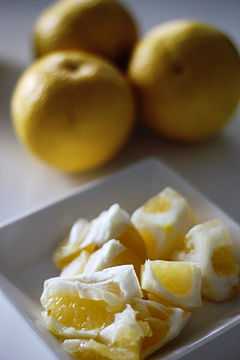Hyuganatsu
| Hyūganatsu | |
|---|---|
 | |
| Scientific classification | |
| Kingdom: | Plantae |
| (unranked): | Angiosperms |
| (unranked): | Eudicots |
| (unranked): | Rosids |
| Order: | Sapindales |
| Family: | Rutaceae |
| Genus: | Citrus |
| Species: | C. tamurana |
| Binomial name | |
| Citrus tamurana Hort. ex Tanaka | |
Hyuganatsu (Citrus tamurana, Japanese: 日向夏) is a citrus fruit and plant grown in Japan. The name comes from Hyūga, the ancient name of Miyazaki Prefecture in Kyushu, where the citrus is said to have originated, while "natsu" (夏) means summer. Hyūganatsu grown outside of Kyushu are sometimes shipped under different names such as Konatsu (小夏), Tosakonatsu (土佐小夏), or New Summer Orange (ニューサマーオレンジ).
Origin
A hyūganatsu sapling was said to have suddenly been found in a Miyazaki garden sometime in the 1820s, after which it became widely cultivated throughout the region. It is thought to be either a mutated yuzu or perhaps more likely, a chance hybrid between yuzu and pomelo.[1]
Description
The fruit is of medium size and its shape is round to slightly oblong. When ripe, it turns a light yellow. Its flesh is juicy and sweet with a slightly sour taste.[1] It is usually eaten cut up, sprinkled with sugar and with most of its rather thick pith intact.
The fruit's oil is higher than other citrus fruits in trans-β-farnesene, l-carvone, and has a higher number of ketones.[2]
See also
References
- ↑ 1.0 1.1 Willard Hodgson, Robert (1967). "Horticultural Varieties of Citrus". The Citrus Industry 1. Retrieved 15 February 2012.
- ↑ Choi, Hyang-Sook; Sawamura, Masayoshi (1 October 2000). "Composition of the Essential Oil of Hort. ex Tanaka (Hyuganatsu)". Journal of Agricultural and Food Chemistry 48 (10): 4868–4873. doi:10.1021/jf000651e.
External links
| Wikimedia Commons has media related to Hyuganatsu. |
Scholarly
- Hyuga Natsu at Citrus Variety Collection
- Hyuganatsu orange (Citrus tamurana Hort. Ex Tanaka) contains a water soluble substance that suppresses bone loss in ovariectomized rats.
- Effects of storage conditions on the composition of Citrus tamurana Hort. ex Tanaka (hyuganatsu) essential oil



